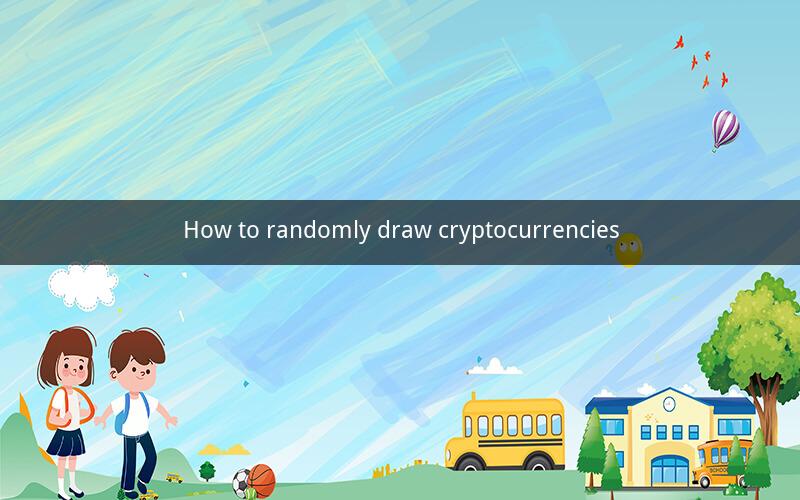
How to Randomly Draw Cryptocurrencies: A Comprehensive Guide
Table of Contents
1. Introduction to Random Drawing of Cryptocurrencies
2. Understanding Cryptocurrency Drawings
3. Setting Up a Cryptocurrency Drawing Platform
4. Choosing a Random Drawing Algorithm
5. Implementing the Random Drawing Algorithm
6. Ensuring Fairness and Transparency
7. Integrating with Blockchain Technology
8. Security Measures for Cryptocurrency Drawings
9. Marketing and Promotion of Cryptocurrency Drawings
10. Legal Considerations for Cryptocurrency Drawings
11. Conclusion
1. Introduction to Random Drawing of Cryptocurrencies
Cryptocurrency drawings have become a popular method for distributing digital assets to participants. This guide aims to provide a comprehensive overview of how to set up and execute a random cryptocurrency drawing.
2. Understanding Cryptocurrency Drawings
A cryptocurrency drawing involves selecting winners from a pool of participants to receive rewards in the form of cryptocurrencies. These rewards can be in various denominations, depending on the event or contest.
3. Setting Up a Cryptocurrency Drawing Platform
To initiate a cryptocurrency drawing, you need to create a platform that can handle the registration of participants, allocation of rewards, and the random selection process. Here are the key components to consider:
- User registration: Allow participants to create accounts and provide necessary information.
- Reward allocation: Decide on the number of winners and the reward denominations.
- Random selection algorithm: Choose a reliable algorithm to ensure fairness.
- Blockchain integration: Integrate with a blockchain platform for secure and transparent transactions.
4. Choosing a Random Drawing Algorithm
Selecting an appropriate random drawing algorithm is crucial to ensure fairness and randomness. Here are some commonly used algorithms:
- True Random Number Generator (TRNG): Utilize hardware-based randomness to generate a seed value.
- Cryptographically Secure Pseudo-Random Number Generator (CSPRNG): Employ mathematical algorithms to generate random numbers.
- Hashing: Utilize cryptographic hashing functions to create a secure and unpredictable outcome.
5. Implementing the Random Drawing Algorithm
Once you have selected an algorithm, implement it within your platform. This involves:
- Integrating the algorithm into the backend system.
- Ensuring the algorithm is accessible and scalable.
- Conducting thorough testing to verify its effectiveness and fairness.
6. Ensuring Fairness and Transparency
To maintain the integrity of the cryptocurrency drawing, it is essential to ensure fairness and transparency. Consider the following measures:
- Document the drawing process and make it accessible to participants.
- Utilize third-party auditors to verify the randomness and fairness of the drawing.
- Implement measures to prevent fraud or tampering with the algorithm.
7. Integrating with Blockchain Technology
Integrating with a blockchain platform provides enhanced security, transparency, and immutability. Here's how you can do it:
- Choose a suitable blockchain platform (e.g., Ethereum, Bitcoin) based on your requirements.
- Develop smart contracts to automate the reward distribution process.
- Utilize blockchain features like non-custodial wallets and smart contract execution for secure transactions.
8. Security Measures for Cryptocurrency Drawings
To protect participants and ensure the integrity of the drawing, implement the following security measures:
- Implement strong password policies and two-factor authentication for account access.
- Utilize secure communication protocols, such as HTTPS, to protect data during transmission.
- Regularly update and patch your platform to address any potential vulnerabilities.
9. Marketing and Promotion of Cryptocurrency Drawings
To attract participants and increase the reach of your cryptocurrency drawing, consider the following marketing strategies:
- Utilize social media platforms to promote the drawing and engage with potential participants.
- Collaborate with influencers or communities to amplify your message.
- Offer incentives, such as additional rewards or exclusive content, to encourage participation.
10. Legal Considerations for Cryptocurrency Drawings
Ensure that your cryptocurrency drawing complies with relevant legal and regulatory requirements. Consider the following aspects:
- Verify that the drawing is compliant with local and international laws.
- Consult with legal professionals to ensure the legality of the rewards and terms and conditions.
- Be transparent about the rules and regulations governing the drawing.
11. Conclusion
Random cryptocurrency drawings can be an effective way to distribute digital assets to participants. By following the steps outlined in this guide, you can set up a secure, fair, and transparent drawing process. Remember to consider legal and security measures to protect participants and ensure the integrity of the event.
---
Frequently Asked Questions
1. What is a random cryptocurrency drawing?
A random cryptocurrency drawing is a contest where winners are selected randomly from a pool of participants to receive rewards in the form of cryptocurrencies.
2. Why should I use a random drawing algorithm?
A random drawing algorithm ensures fairness and randomness, preventing any bias or manipulation in the selection process.
3. Can I use any blockchain platform for the drawing?
Yes, you can choose any blockchain platform that suits your requirements, such as Ethereum, Bitcoin, or Binance Smart Chain.
4. How can I ensure the security of participants' data?
Implement strong password policies, two-factor authentication, and secure communication protocols to protect participants' data.
5. Can I promote my cryptocurrency drawing on social media?
Absolutely! Utilize social media platforms to promote your drawing and engage with potential participants.
6. What are the legal considerations for a cryptocurrency drawing?
Ensure compliance with local and international laws, consult with legal professionals, and be transparent about the rules and regulations.
7. How can I verify the randomness of the drawing?
Utilize third-party auditors, document the drawing process, and consider using cryptographic hashing functions for added security.
8. Can I offer additional rewards for participating in the drawing?
Yes, offering additional rewards or exclusive content can encourage participation and increase the reach of your drawing.
9. How do I integrate a random drawing algorithm into my platform?
Integrate the algorithm into your backend system, conduct thorough testing, and ensure scalability and accessibility.
10. What are the key components of a cryptocurrency drawing platform?
Key components include user registration, reward allocation, random selection algorithm, blockchain integration, security measures, and marketing strategies.